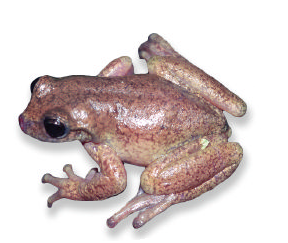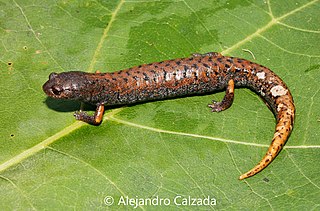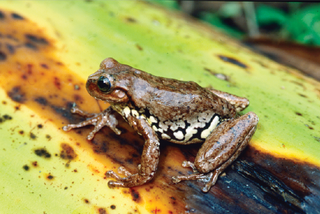
The Mexican blind lizard is a species of legless lizard in the family Dibamidae, and the only species in the genus Anelytropsis. It is endemic to Mexico. They look like Amphisbaenia, but are in fact, only distantly related.

Charadrahyla is a genus of frogs in the family Hylidae. It is endemic to tropical southern Mexico. The generic name was derived from Greek charadra ("ravine") and Hyla, in reference to the habits of these frogs. Accordingly, common name ravine treefrogs has been coined for the genus.
Megastomatohyla is a genus of frogs in the family Hylidae. They are endemic to the cloud forests of central Veracruz and Oaxaca, Mexico. All are rare species with restricted distributions. The generic name is derived from Greek mega (="large") and stem of the genitive stomatos (="mouth"), referring to the enlarged oral disc of the tadpoles, juxtaposed with Hyla, the genus in which the four Megastomatohyla species were previously placed. Common name large-mouthed treefrogs has been coined for this genus.

Crotalus intermedius is a venomous pit viper species found in central and southern Mexico. Three subspecies are currently recognized, including the nominate subspecies described here.
Charadrahyla nephila is a species of frog in the family Hylidae. It is endemic to Mexico and occurs in the Sierra de Juárez and Sierra Mixe in the northern Oaxacan highlands; there is also a questionable record from the Sierra de los Tuxtlas, Veracruz. Prior to its description, it was mixed with Hyla chaneque. The specific name nephila is derived from Greek nephos ("cloud") and philia ("fondness"), referring to the cloud forest habitat of this species. Common name Oaxacan cloud-forest treefrog has been coined for it.
Ecnomiohyla thysanota, also known as Cerro Mali treefrog, is a species of frog in the family Hylidae. It is endemic to Panama where it is known from its type locality, Cerro Malí in eastern Serranía de Darién, near the border to Colombia, where it might also occur. This arboreal species is only known from a single specimen, the holotype.
Charadrahyla pinorum is a species of frog in the family Hylidae. It is endemic to the Pacific slopes of Sierra Madre del Sur between central Guerrero and southwestern and central Oaxaca, Mexico. Common names pine wood treefrog and Mexican pine woods treefrog have been proposed for it. Its closest relative is probably Charadrahyla juanitae.

Sarcohyla bistincta, also known as the Mexican fringe-limbed treefrog or Cope's streamside treefrog, is a species of frog in the family Hylidae. It is endemic to Mexico; it is widespread and occurs from southern Sinaloa and Durango southeastward to Veracruz and Oaxaca. The nominal Sarcohyla bistincta consists of several lineages that may eventually be described as distinct species.

Sarcohyla labeculata is a species of frog in the family Hylidae. It is endemic to the Sierra Mixe in Oaxaca, Mexico. This species was resurrected from synonymy of Sarcohyla bistincta in 2018, while at the same time bringing Sarcohyla calthula and Sarcohyla ephemera in its synonymy. Common name Mixe streamside treefrog has been proposed for this species, whereas the common names yellow-robed treefrog and Cerro Las Flores spikethumb frog referred to the former S. calthula and S. ephemera, respectively.
Sarcohyla celata, also known as the Oaxaca treefrog, is a species of frog in the family Hylidae. It is endemic to Mexico and only known from the Sierra de Juárez in northern Oaxaca. After having not been seen after 1984, it was feared that the species might be extinct. However, the species was rediscovered in field surveys during 2011–2014 and some subpopulations are at healthy levels.
Sarcohyla chryses, also known as the golden treefrog, is a species of frog in the family Hylidae. It is endemic to the Sierra Madre del Sur in Guerrero, Mexico. Its sister species is Sarcohyla mykter.
Sarcohyla crassa is a species of frog in the family Hylidae. It is endemic to the Sierra Madre de Oaxaca of Oaxaca, Mexico. It is also known as the aquatic treefrog, or when referring to the former Hyla bogertae, Bogert's aquatic treefrog.
Sarcohyla cyanomma, also known as the blue-eyed aquatic treefrog, is a species of frog in the family Hylidae. It is endemic to Mexico and only known from the northern slope of Cerro Pelón, in Sierra de Juárez in northern Oaxaca. It is feared that the species might be extinct.

Sarcohyla mykter, also known as the keelsnout treefrog or keel-snouted treefrog, is a species of frog in the family Hylidae. It is endemic to the Sierra Madre del Sur in Guerrero, Mexico. Its sister species is Sarcohyla chryses.
Sarcohyla sabrina, also known as the Sierra Juarez treefrog, is a species of frog in the family Hylidae. It is endemic to the northern slopes of Sierra de Juárez in northern Oaxaca, Mexico. The specific name sabrina is Latin for river nymph and refers to the close association of this species with streams.
Pseudoeurycea aurantia, commonly known as Peña Verde salamander, is a species of salamander in the family Plethodontidae. It is endemic to Oaxaca, Mexico and only known from its type locality near Peña Verde, which is the northernmost high peak in the Sierra de Juárez.

Pseudoeurycea mystax is a species of salamander in the family Plethodontidae. It is endemic to Mexico and only known from the area of its type locality in the Sierra Madre de Oaxaca near Ayutla, Oaxaca. Its common name is mustache false brook salamander or mustached false brook salamander. The specific name refers to the whitish protuberances on the lips that resemble a mustache in the frontal view of the male holotype.
Sarcohyla miahuatlanensis, or the Sierra Miahuatlan spikethumb frog, is a species of frog in the family Hylidae. It is endemic to Mexico and only known from its type locality near Candelaria Loxicha on the Sierra de Miahuatlán in Oaxaca.

Sarcohyla is a genus of frogs in the family Hylidae. It is endemic to Mexico and is found in the montane parts of the country between Durango in the north and Guerrero in the south. These frogs typically occur in pristine habitats along streams in pine-oak woodland at elevations between 1,500 and 3,100 m above sea level. The generic name is derived from the Greek sarkodes meaning "fleshy" in combination with Hylas and refers to the thick, glandular skin characteristic of most of the species in the genus.

Rheohyla is a genus of frogs in the family Hylidae. As currently recognized, it is monotypic, containing only Rheohyla miotympanum, also known as the small-eared hyla or small-eared treefrog. However, the nominal species likely is a complex of more than one species. It is endemic to eastern and central Mexico. The generic name refers to streams, the breeding habitat of this frog. The specific name is derived from Greek meion, a diminutive prefix, together with Greek tympanon (='drum') and refers to the small tympanum.









